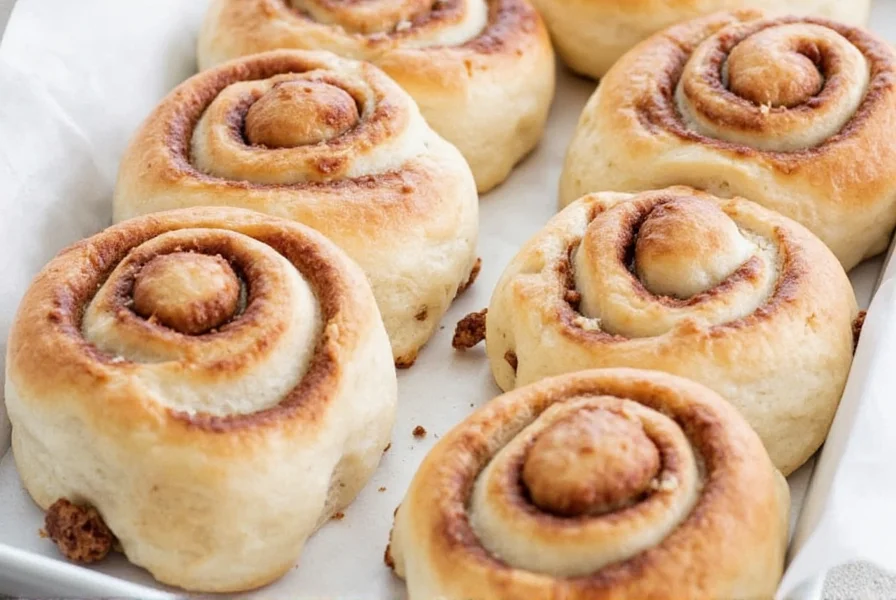When you're craving warm, aromatic cinnamon rolls but don't have hours to spend mixing, rolling, and proofing dough, Rhodes Cinnamon Rolls provide a reliable solution. These frozen dough products have become pantry staples for home bakers seeking convenience without completely sacrificing quality. Understanding how to properly prepare and enhance these ready-made rolls can transform your baking experience from ordinary to exceptional.
What Makes Rhodes Cinnamon Rolls Different
Rhodes Food Group has perfected frozen dough technology that maintains freshness while offering remarkable convenience. Unlike canned cinnamon roll products that use chemical leaveners, Rhodes rolls contain yeast, requiring proper rising time but delivering superior texture and flavor development. The dough's formulation allows for refrigerator thawing (8-12 hours) or same-day preparation using the "quick-rise" method many home bakers prefer.

Step-by-Step Preparation Guide
While Rhodes Cinnamon Rolls come with basic instructions, professional bakers know several techniques that significantly improve results. The standard preparation process involves:
- Thawing frozen rolls either overnight in the refrigerator or using the quick-rise method
- Allowing proper rising time until doubled in size
- Baking at precise temperature for optimal browning
- Applying icing at the perfect moment for ideal consistency
| Preparation Method | Thawing Time | Rising Time | Best For |
|---|---|---|---|
| Refrigerator Method | 8-12 hours | 2-3 hours | Planning ahead, best flavor development |
| Quick-Rise Method | 30-45 minutes | 1-1.5 hours | Same-day preparation, immediate results |
| Overnight Refrigerator | 12-16 hours | 1 hour at room temperature | Morning baking with minimal morning effort |
Avoiding Common Rhodes Cinnamon Rolls Mistakes
Many home bakers encounter issues with frozen cinnamon rolls due to improper handling. The most frequent problems include:
- Under-rising - Placing rolls in too-cold environment prevents proper expansion
- Over-baking - Setting oven temperature too high creates burnt exteriors with raw centers
- Icing timing errors - Applying icing too early melts it; too late makes it harden improperly
- Crowded baking - Not leaving enough space between rolls causes uneven baking
Professional bakers recommend using an oven thermometer to verify actual temperature, as many home ovens have significant calibration issues that affect baking results. For perfect Rhodes cinnamon rolls baking results, maintain consistent oven temperature and monitor rolls during the final baking minutes.
Creative Variations for Rhodes Cinnamon Rolls
While Rhodes Cinnamon Rolls taste delicious straight from the package, several simple modifications can elevate them significantly. Consider these expert-approved variations:
- Luxury filling enhancement - Before baking, gently separate rolls and add extra cinnamon, brown sugar, or even chopped pecans between layers
- Gourmet icing upgrades - Mix the included icing with cream cheese, caramel, or citrus zest for sophisticated flavor profiles
- Bread pudding transformation - Cube slightly stale rolls and use them in a decadent bread pudding recipe
- Savory-sweet breakfast bake - Layer rolls with cooked bacon and maple syrup for a brunch specialty

Storage and Reheating Techniques
Proper storage maintains the quality of Rhodes Cinnamon Rolls both before and after baking. For unprepared rolls, keep them frozen until ready to use, avoiding repeated freeze-thaw cycles. Baked rolls maintain freshness for 2-3 days at room temperature in an airtight container.
For optimal reheating of Rhodes cinnamon rolls, professional chefs recommend:
- Microwave method: 10-15 seconds covered with damp paper towel
- Oven method: 5 minutes at 300°F (150°C) for revived freshness
- Air fryer technique: 3 minutes at 320°F (160°C) for slightly crisp exterior
Rhodes vs. Homemade Cinnamon Rolls
While Rhodes Cinnamon Rolls offer undeniable convenience, understanding their place in your baking repertoire helps set proper expectations. Homemade rolls typically feature more complex flavor development from longer fermentation and customizable ingredients. However, Rhodes products provide consistent results with minimal time investment—particularly valuable for beginners or those with time constraints.
The texture difference primarily comes from the yeast activity and butter quality. Professional bakers note that enhancing Rhodes rolls with additional high-quality ingredients bridges much of the gap between store-bought and homemade. For special occasions, consider using Rhodes as a starting point rather than the final product.
Frequently Asked Questions
Can you bake Rhodes cinnamon rolls without rising them?
No, proper rising time is essential for Rhodes cinnamon rolls. The yeast needs time to activate and create the light, airy texture these rolls are known for. Skipping the rising step results in dense, tough rolls with poor texture and flavor development.
How do you prevent Rhodes cinnamon rolls from becoming dry?
To prevent dryness when baking Rhodes cinnamon rolls, avoid overbaking by checking 2-3 minutes before the minimum recommended time. Additionally, cover rolls with foil during the final baking minutes if they're browning too quickly. Proper storage in an airtight container after cooling also maintains moisture.
What's the best way to thaw Rhodes cinnamon rolls quickly?
The quick-rise method for Rhodes cinnamon rolls involves placing frozen rolls in a greased pan, covering with plastic wrap coated with cooking spray, and setting in a warm location (80-85°F/27-29°C). This typically takes 1-1.5 hours until doubled in size. Avoid direct heat sources which can cook the exterior while the interior remains frozen.
Can you freeze baked Rhodes cinnamon rolls?
Yes, fully baked Rhodes cinnamon rolls freeze exceptionally well. Cool completely, wrap individually in plastic wrap, then place in airtight freezer bags. They maintain quality for 2-3 months. To serve, thaw at room temperature for 30 minutes then reheat using microwave, oven, or air fryer methods for best texture restoration.
Why do my Rhodes cinnamon rolls collapse after baking?
Collapsing Rhodes cinnamon rolls typically indicate under-rising or oven temperature issues. Ensure rolls have doubled in size before baking—under-risen dough lacks sufficient structure. Additionally, avoid opening the oven door during the first two-thirds of baking time, as temperature fluctuations can cause collapse. Verify your oven temperature with a separate thermometer for accuracy.











 浙公网安备
33010002000092号
浙公网安备
33010002000092号 浙B2-20120091-4
浙B2-20120091-4